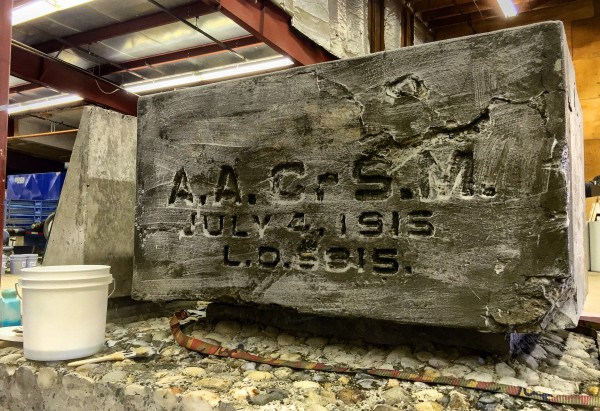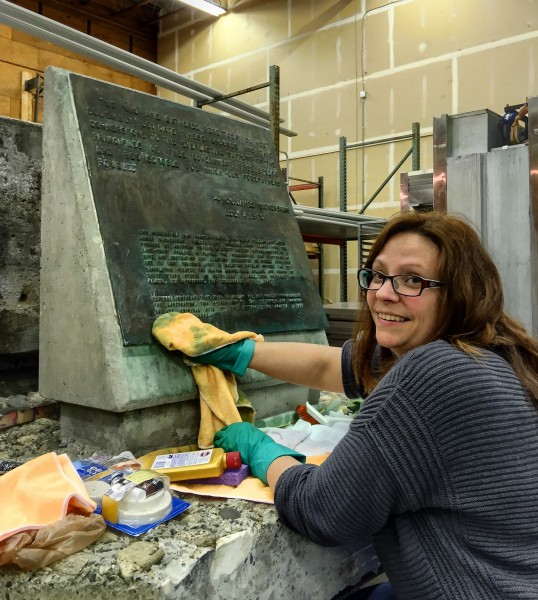History cast in stone
July 6, 2015
Theresa Bakker
907-474-6941

Imagine an object that has lasted a hundred years. A big object, made of stone. Too heavy to move by hand, it’s weathered and worn. Bits of its facade have crumbled away. The metal surface of its plaque has rusted and discolored.
Certainly this item has a story, or many, to tell.
For the University of Alaska Fairbanks cornerstone, all of this is true. This concrete block has been through its share of adventures. And now the university has hosted a community celebration so the cornerstone could be reinstalled in the location where it was first placed in 1915.
But first, it was important to make sure the object — and its history — are protected for future generations.
Usually a cornerstone signifies the foundation of a building. When the cornerstone was installed in the ground in 1915, it was meant to be a symbol for the community, a cause worth fighting for, said Angela Linn, senior collections manager of ethnology and history at the University of Alaska Museum of the North.
“This is the first historical artifact associated with the university. It served, at the time of its initial placement, as a symbol of what could be for the people of Interior Alaska and beyond.”

Linn worked on a restoration project to preserve the cornerstone in advance of the university’s centennial. She recently restored the stone’s metal plaque while museum operations manager Kevin May made a copy of the block face so that a cast can be made for exhibit.
Both of these tasks are common jobs for people working with museum artifacts and specimens. In fact, making a mold of the cornerstone involved the same steps paleontologists take to replicate dinosaur footprints and fossils.
“Just like any object of this age, the stone has seen its share of cosmetic touch-ups,” Linn said. “It’s already been moved a few times, including one unintentional transfer during the construction of the Bunnell Building. But now the stone will be placed back in its original — and hopefully permanent — location this summer.”
In 100 years, everything has changed, and the stone has witnessed it all. Linn imagines it like a time-lapse movie, with the camera focused on the stone as the decades fly by around it. “I sincerely hope it will last another 100 years. If not, this mold we’re making will help us remember it exactly as it is today.”
Before this site was identified as a prime location for a university, the land itself had a long history. For many millennia, the Athabascan residents of Interior Alaska met on the university ridge, called Troth Yeddha’, to organize and work together. University leaders have honored that legacy by establishing a park adjacent to the museum. An indigenous studies center is also planned for the site, which has a panoramic view of the Tanana River valley and the Alaska Range.
In June 1915, at the end of a rough road cut from the railroad tracks, a group of Fairbanks business leaders gathered where the UAF Bunnell Building now stands. James Wickersham, Alaska’s territorial delegate, asked them to help place the cornerstone.
Wickersham had just returned from Washington D.C., where he convinced Congress to set aside land for the college. Now he wanted to prepare for the next hurdle.
He and his supporters still had to persuade the territorial legislature to establish the Alaska Agricultural College and School of Mines in Fairbanks, a place some legislators considered merely a temporary gold camp. It took two more years before representatives from Interior Alaska managed to put through legislation to accept the land grant offer by the federal government. An additional bill to create the college only squeaked by in the House on a vote of nine to seven. If one member had changed a vote, it would have failed.
Now the university is celebrating the cornerstone’s past, including the time it was misplaced! In the 1950s, several decades after the stone was laid, a construction worker accidentally moved it to a debris field. After a relentless campaign by the UAF Alumni Association’s first director to track it down, the stone was returned.
On Sept. 12, 1962, the university rededicated the cornerstone (for the first time). A new bronze plaque was installed, explaining the stone’s symbolism. This time, the stone lasted almost 50 years in the same spot before it was again removed to make way for construction.
More recently, the cornerstone was replaced at a ceremony on July 6, 2015 sponsored by the UAF Alumni Association to kick off the university’s centennial celebration. Current director Kate Ripley said it’s a fitting venture, as the association is nearly as old as the university itself.
"The cornerstone symbolizes the foundation of the university,” she said. “The first group of alumni organized in 1927, so we're a natural partner. We're proud of UAF and everything this university means for our state."
The celebration began at Troth Yeddha’ and ended with the placing of the cornerstone in its original location. But this time, it will be preserved in other forms, as well. The mold made by the museum will be used to make a replica preserved in the history collection. It will also be featured in a special exhibit at the UA Museum of the North, planned to commemorate the university’s centennial in 2017.


